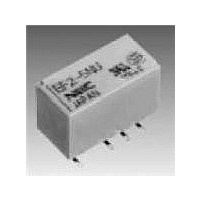ED2-9NU NEC, ED2-9NU Datasheet - Page 14

ED2-9NU
Manufacturer Part Number
ED2-9NU
Description
Low Signal Relays - PCB 9VDC NON LATCH
Manufacturer
NEC
Series
ED2r
Datasheet
1.ED2-9NU.pdf
(15 pages)
Specifications of ED2-9NU
Contact Form
2 Form C (DPDT)
Coil Voltage
9 V
Power Consumption
55 mW
Contact Carry Current
2 A
Termination Style
Solder Tail
Maximum Switching Current
1 A
Contact Rating
2 A
Lead Free Status / Rohs Status
Lead free / RoHS Compliant
Available stocks
Company
Part Number
Manufacturer
Quantity
Price
Company:
Part Number:
ED2-9NU
Manufacturer:
NEC
Quantity:
5 400
●All specifications in this catalog and production status of products are subject to change without notice. Prior to the purchase, please contact NEC TOKIN for updated product data.
●Please request for a specification sheet for detailed product data prior to the purchase.
●Before using the product in this catalog, please read "Precautions" and other safety precautions listed in the printed version catalog.
4. Notes on mounting relays
- When mounting a relay onto a PC board using an
automatic chip mounter, if excessive force is applied to the
cover of the relay when the relay is chucked or inserted, the
cover may be damaged or the characteristics of the relay
degraded. Keep the force applied to the relay to within 1 kg.
- Avoid bending the pins to temporarily secure the relay to
the PC board. Bending the pins may degrade sealability or
adversely affect the internal mechanism.
- It is recommended to solder the relay onto a PC board
under the following conditions:
<1> Reflow soldering
Refer to the recommended soldering temperature profile.
<2> Flow soldering
Solder temperature: 260°C max., Time: 5 seconds max.
Preheating: 110~ 120°C /110 sec. (max.)
<3> Manual soldering
Solder temperature: 350°C, Time: 2~3 seconds
- Ventilation immediately after soldering is recommended.
Avoid immersing the relay in cleaning solvent immediately
after soldering due to the danger of thermal shock being
applied to the relay.
- Use an alcohol-based or water-based cleaning solvent.
Never use thinner and benzene because they may damage
the relay housing.
- Do not use ultrasonic cleaning because the vibration
energy generated by the ultrasonic waves may cause the
contacts to remain closed.
5. Handling
- Relays are packaged in magazine cases for shipment. If a
space is created in the case after some relays have been
removed, be sure to insert a stopper to secure the remaining
relays in the case. If relays are not well secured, vibration
during transportation may cause malfunctioning of the
contacts.
- Exercise care in handling the relay so as to avoid dropping
it or allowing it to fall. Do not use a relay that has been
dropped. If a relay drops from a workbench to the floor, a
shock of 9,800 m/s2 (1,000 G) or more is applied to the relay,
possibly damaging its functions. Even if a light shock has
been applied to the relay, thoroughly evaluate its operation
before using it.
- Latching relays are factory-set to the reset state for
shipment. A latching relay may be set, however, by vibration
or shock applied while being transported. Be sure to forcibly
reset the relay before using it in the application set. Also note
that the relay may be set by unexpected vibration or shock
when it is used in a portable set.
- The sealability of a surface-mount (SMT) relay may be lost
if the relay absorbs moisture and is then heated during
soldering. When storing relays, therefore, observe the
following points:
<1> For standard packing, please use relays within 12
months after delivery. (Storage conditions: 30 °C / 60% RH)
If the relays have moisture absorption, dehumidify as follows.
<2> For MBB packing, please use relays within 2 years after
14
Tape packing: 50±5 °C, 200~300 hours.
Simple relay: 85±5 °C, 48 hours.
delivery.
(Storage conditions: 30 °C / 60% RH)
After open MBB packing, please use within 3 months.
(Storage conditions: 30 °C / 60% RH)
ED2/EF2 SERIES
2007.08.03 P0890EMDD03VOL03E







